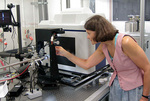Bragg legacy lives on
 Alumni Alumni
A new, hi-tech research facility named in honour of the Nobel Prize-winning father-and-son team Sir William and Sir Lawrence Bragg has been opened at the University of Adelaide. The Bragg Crystallography Facility is based in the University's Johnson Building on the North Terrace Campus. The facility will enable researchers to determine the structure of both small and large molecules using a process known as X-ray diffraction. This will play a key role in research into areas such as cancer, Alzheimer's and other diseases, and the development of salt- and drought-tolerant crops, bio-fuels and nanotechnology. With funding from an Australian Research Council (ARC) Linkage Infrastructure, Equipment and Facilities grant, the new facility has been established by the three South Australian universities and with assistance from the Hanson Institute, SA Museum, Bio-Innovation SA, and the Royal Institution of Australia. "This facility has strong historical links with Sir William and Sir Lawrence Bragg, who conducted experiments into X-ray radiation and diffraction here at the University of Adelaide," said the director of the facility, ARC Future Fellow Dr Chris Sumby from the School of Chemistry & Physics. "These two truly exceptional scientists invented the 'Bragg's X-ray Diffraction Law', which was the result of their groundbreaking research with X-rays at the end of the 19th century and the beginning of the 20th century. "This law is fundamental to three-dimensional (3D) structural determination of molecules, including large molecules such as proteins and DNA." He said the new facility was established to meet the needs of the South Australian crystallographic community. "We now have two state-of-the-art diffractometers capable of structure determination of small and large molecules. The strategic importance of the facility is highlighted by the recent establishment of several South Australian structural research groups, such as at the Australian Centre for Plant Functional Genomics (ACPFG) at the Waite Campus, and completion of the Australian Synchrotron in Victoria," said Associate Professor Maria Hrmova from the ACPFG. "The Bragg Crystallography Facility will also support undergraduate and postgraduate training in techniques that underpin many areas of scientific endeavour, for example structural biology and nanotechnology," said Dr Sumby. "The new facility will help both scientists and students in South Australia to peer into structural and functional relationships of small and large molecules, and this will advance knowledge, understanding and culture in our society and research environment," said Associate Professor Hrmova.
|







